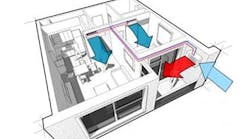by Valerie Stakes, editorial coordinator/associate editor
Mold seems to be the word on everyone’s lips these days. Television programs and
consumer magazines are filled with warnings about its hazardous effects and with stories on how homeowners can protect themselves from this deadly scourge.
Also on everyone’s lips is liability. Last year, Melinda Ballard was awarded more than $32 million in her suit against Farmers Insurance for their negligence in the remediation of the deadly mold contaminating her home in Dripping Springs, TX.
More recently, entertainer Ed McMahon filed a $20 million lawsuit against his home insurance company, claiming the botched repair on a broken pipe lead to toxic mold that spread throughout the house, making his family sick and killing his dog. In both cases, everyone involved in the remediations, including HVAC contractors, were named in the suits.
Amidst this whirlwind of fingerpointing is growing concern and confusion over the extent of HVAC contractor
liability in indoor air quality (IAQ)
problems.
Furthermore, this issue has left many contractors wondering whether mold remediation is huge niche opportunity, or a path fraught with legal battles and, possibly, financial ruin.
You May Already Be Liable
According to Vikki Nicholas, co-owner of Bay Temperature Control in Houston, TX, HVAC contractors are inherently liable for IAQ and mold problem because of the nature of their work.
“Contractors must understand how the installation and service work they perform has a direct impact on IAQ,”she says. “Regardless of if you’re involved in mold remediation or not, if something is amiss that can be traced back to the system, you can be held accountable.”
In addition, Ballard’s landmark settlement has led Texas insurance companies to fight for a payout cap of $5,000 to homeowners in mold-related cases. Other states will likely follow suit.
“With their policies restricted, contractors may be even more vulnerable as homeowners charge, ‘You put in the system, therefore my mold problems are your financial responsibility,’” Nicholas says.
Finally, there’s a growing presumption by insurers that contractors are guilty, which can lead to problems even when it’s not your fault. This is something Nicholas has witnessed firsthand.
“One of our customers recently experienced an extreme mold problem. We installed their system in 1996, and they hadn't requested maintenance or anything else since that time,” Nicholas says. “The plumbing company that did the mold testing blamed us, insisting that we installed the drain line improperly.”
The real culprit, however, was the foundation, which cracked in several places and burst the plumbing line throughout the entire house. Mold spread from the bathroom area where the drain line fed into the plumbing stack, and continued throughout the structure.
“Because we were initially blamed for the problem, our insurance company automatically paid the claim without consulting with us or sending an inspector,” says Nicholas. “Instead, our carrier paid $80,000 to save me from further litigation. I would have preferred to go to court because we could have won.”
Prevention is the Best Defense
Because of the the direct relationship between HVAC and indoor air quality, proper design and installation are two of the most powerful ways contractors can protect themselves from mold-related litigation.
“The best prevention is to do the job right the first time, regardless if it’s a retrofit or new installation job,” says Nicholas. “Leaks resulting from improperly connected drain lines, a humidity level more than 40 to 50%, ill-fitting duct work that hinders system capacity and causes short cycling — all of these factors contribute to humidity problems,” she adds.
Gary Brackett, service operations manager for TDIndustries, Phoenix, AZ, agrees. “Design it right or fix the system to be the way it should have been designed the first time,” he says. “Don’t cut corners, either. We know our customers want to save money, but we have to provide a solution we can stand behind. You want to be able to bring in five other contractors who would look at your work and say, ‘That’s what I would have done.’”
A crucial design consideration is geographic region. According to David Debien, president of Central City Air, Houston, TX, contractors can avoid the liability issue with proper, regionally targeted design.
“A system that works in Denver or Phoenix will not remove sufficient humidity in the hot, humid climate of Houston,” he says. “Furthermore, there’s high mold potential when you only take out sensible heat and ignore latent heat.”
For example, when designing systems for his Houston customers, Debien often downsizes the evaporator coils to provide increased humidity removal. According to Debien, a standard coil-condensing unit match-up brings down the temperature but not the humidity in the Houston climate.
“We match a 4-ton coil with a 5-ton condensing unit, which increases the humidity removal level by up to 25%, and results in only a loss of 110 SEER and of 500 Btus,” Debien states.
This customized design approach has been highly successful, and Debien says he’s received no complaints or lawsuits about mold from his customers.
Regardless of climate, Debien stresses that to prevent mold problems, all contractors must understand the refrigeration process and look at factors such as static pressure, superheat, temperature drop, subcooling, along with proper airflow and air distribution.
“You can’t just install the system, get the head and suction pressures the way you think they should be, and walk away. You then end up testing by complaint: when a customer complains, you try to figure it out,” he says.
Getting into the Business
According to Melinda Wood Allen, owner and vice president/education and training director of Enviro-Mold Indoor Air Quality Service Inc., Ft. Worth, TX, the decision to take on mold remediation projects should be thought out carefully.
“Mold remediation is an industry specialization, not a sideline or seasonal work. Employees need thorough training and the opportunity to develop a body of experience on the job,” she says. “In addition, specialized equipment is required and must be decontaminated between jobs to avoid cross-contamination issues.”
Allen adds that when it comes to training, not all programs are created equal.
“There are good mold schools out there. Look for programs that offer at least 24 to 30 hours of instruction and that are taught by instructors who have field experience in mold remediation,”she says.
The courses should cover the characteristics and health effects of mold, and include safety, communication, regulatory, and legal training.
Certification in areas such as asbestos abatement, water restoration, and HVAC systems cleaning is also helpful. “Learn as much as you can about mold, water damage, and IAQ issues. Take any continuing education course or seminar you can get to,” Allen adds. “Organizations such as the The International Association of Mold Remediation Specialists can also help.” (See the “Valuable Resources” sidebar on page 38.)
Outside Expertise
Although a well-trained staff is crucial, it’s equally important to know when to bring in the experts. “When it comes to mold and IAQ problems, we must educate our employees on what to look for, when to be concerned, and when not to be concerned,” says Brackett. “To protect ourselves, we also need to know when the building should be checked out by someone more versed in IAQ than ourselves.”
At Bay Temperature Control, Nicholas and staff partner with an industrial hygienist.
“If a customer brings us in to check a potential problem, we begin by doing an initial testing. We then bring in a certified industrial hygienist who’s a specialist in microbiology. He tests for the source of the problem and determines a remediation plan for us to follow,” Nicholas explains.
Details, Details
While proper system design, training, and expertise are all essential, obtaining the right insurance, developing written programs, and maintaining proper documentation are key to a successful, and less litigious, career in IAQ improvement.
Allen advises, ”The standard commercial general liability policy typically has a pollution exclusion clause. That clause must be removed so that your policy includes environmental/pollution insurance.”
Furthermore, a specific mold remediation rider should be added. The price of these policies are typically based upon percentage of annual sales.
Allen also recommends developing a standard operating procedure (SOP) that covers safety protocols, Occupational Safety Health Administration (OSHA) and Hazcom requirements, documentation standards, and complete work procedures. “Having this SOP gives your client confidence in your ability to handle problems and helps ensure that you’re ready to handle whatever comes up,” she states.
Finally, document all work in worker rosters and daily chronological logs. Photographs and/or videotapes of the conditions before, during, and after the work should also be taken
“Doing a good job isn't enough,” Allen adds. “Any attorney will happily tell you, ‘If you didn’t write it down, it didn’t happen.’ If you properly document that you did good work, you can head most lawsuits off at the pass.”
Valerie Stakes, editorial coordinator/associate editor, can be reached at 216/931-9439 or at [email protected].










